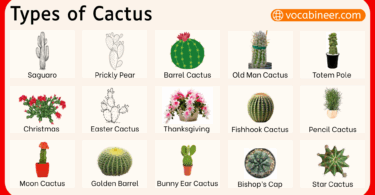Learning the names of different types of plants in English helps students, kids, and ESL learners describe nature, farming, gardening, and everyday surroundings more confidently. From trees and flowers to indoor plants and herbs, this topic builds stronger vocabulary through image-word association. In this post, you’ll discover 100 types of plants with pictures and names, organized by use and category to support easy understanding and better memory.
In This Page
List of 100 Types of Plants in English for Beginners
Here is a complete list of 100 plant names in English, each with a picture to help with recognition and learning. These include flowering plants, indoor plants, trees, succulents, herbs, and farming plants. This visual list supports school education, general vocabulary building, and plant-based conversations.
- Rose
- Tulip
- Sunflower
- Lily
- Daffodil
- Marigold
- Hibiscus
- Jasmine
- Lavender
- Orchid
- Mango Tree
- Neem Tree
- Coconut Tree
- Banyan Tree
- Peepal Tree
- Pine Tree
- Apple Tree
- Guava Tree
- Oak Tree
- Palm Tree
- Snake Plant
- Money Plant
- Peace Lily
- Spider Plant
- ZZ Plant
- Aloe Vera
- Areca Palm
- Rubber Plant
- Pothos
- Chinese Evergreen
- Tulsi
- Mint
- Neem
- Turmeric Plant
- Lemongrass
- Coriander
- Fennel
- Ginger Plant
- Ashwagandha
- Brahmi
- Wheat
- Rice
- Maize
- Barley
- Sugarcane
- Cotton
- Soybean
- Groundnut
- Mustard Plant
- Jute
- Cactus
- Jade Plant
- Echeveria
- Zebra Plant
- Hens and Chicks
- Agave
- Aloe Vera
- Burro’s Tail
- Snake Plant
- Sedum
- Water Lily
- Lotus
- Duckweed
- Water Hyacinth
- Hornwort
- Water Lettuce
- Cattail
- Papyrus
- Elodea
- Anacharis
- Morning Glory
- Bougainvillea
- Ivy
- Pumpkin Plant
- Grapevine
- Pea Plant
- Cucumber Plant
- Bitter Gourd
- Black Pepper
- Bottle Gourd
- Rosemary
- Hibiscus
- Oleander
- Croton
- Boxwood
- Honeysuckle
- Azalea
- Camellia
- Hydrangea
- Spirea
- Banana Plant
- Strawberry Plant
- Pomegranate Plant
- Papaya Plant
- Orange Tree
- Lemon Tree
- Grapefruit Tree
- Chiku Plant
- Fig Plant
- Litchi Tree

Flowering Plants Names in English with Pictures
Flowering plants add beauty to gardens, homes, and parks. These plants produce flowers and are often colorful and fragrant.
- Rose – Known for its soft petals and lovely scent.
- Sunflower – Tall plant with a big yellow flower head.
- Lily – Elegant plant with large petals, often white or pink.
- Tulip – A spring flower, common in red, yellow, and purple.
- Marigold – Bright orange or yellow flower, often used in decorations.
- Hibiscus – Tropical flower with wide, colorful petals.
Trees Names in English (Fruit and Non-Fruit Trees)
Trees are tall, woody plants that give us shade, oxygen, and fruit. Learning tree names is useful for science lessons and nature talk.
- Mango Tree – Gives sweet mango fruits in summer.
- Neem Tree – Known for its medicinal leaves and bitter taste.
- Peepal Tree – A sacred tree with heart-shaped leaves.
- Coconut Tree – Tall tree found in coastal areas; gives coconuts.
- Guava Tree – Medium-sized tree that grows guava fruits.
- Banyan Tree – Wide-spreading tree with hanging roots.
Indoor Plants Names in English for Home and Classroom Use
Indoor plants grow well inside homes, schools, or offices. They improve air quality and add green decor.
- Snake Plant – Long leaves, needs very little care.
- Money Plant – Climber plant, believed to bring luck.
- Peace Lily – White flowering plant, easy to grow indoors.
- Areca Palm – Soft-leaf plant, perfect for corners.
- Spider Plant – Striped leaves with baby plants hanging.
- ZZ Plant – Glossy leaves, grows in low light.
Farming Plants Names in English for Students
Farming plants include crops and grains grown for food. These names are important in school science, agriculture, and environmental studies.
- Wheat – Grain used to make bread and roti.
- Rice – Staple food crop in many countries.
- Maize (Corn) – Yellow kernels used for food and fodder.
- Barley – A grain used in soups and cereals.
- Sugarcane – Tall grass used for making sugar.
- Cotton Plant – Gives soft fibers for making clothes.
Medicinal and Herbal Plants Names in English
These plants are used in natural medicine and home remedies. They are part of traditional health practices in many cultures.
- Aloe Vera – Used for skin, burns, and hair care.
- Tulsi (Holy Basil) – Helpful in colds, cough, and immunity.
- Mint – Used in tea, toothpaste, and digestion.
- Neem – Antibacterial properties; used in soaps and oils.
- Turmeric Plant – Roots used as a spice and antiseptic.
- Lemongrass – Used in herbal teas and oils.
Succulent and Cactus Plants Names with Images
Succulents and cacti are drought-resistant plants that store water in their leaves or stems. They are ideal for hot climates and indoor decoration.
- Cactus – Spiny plant that grows in deserts.
- Jade Plant – Small green succulent with round leaves.
- Aloe Vera – Doubles as a succulent and herbal plant.
- Echeveria – Rose-shaped leaves, often colorful.
- Zebra Plant – Has striped leaves like a zebra.
- Hens and Chicks – Small succulent clusters that multiply fast.
Read More




